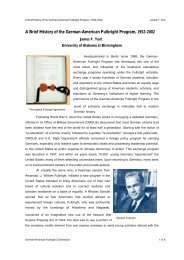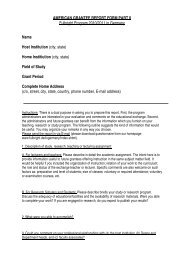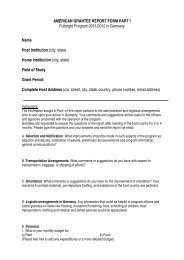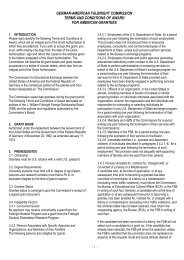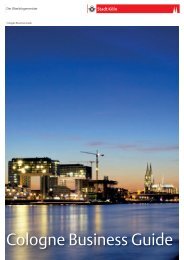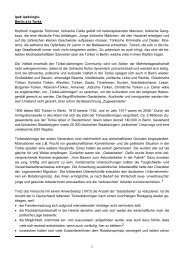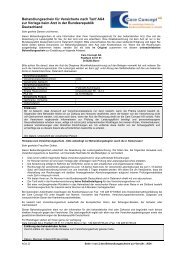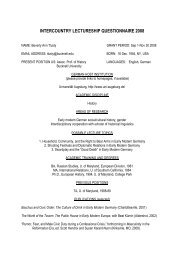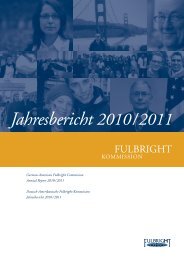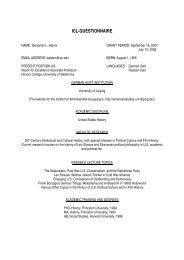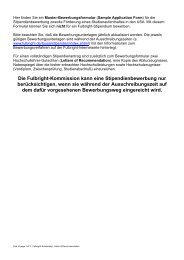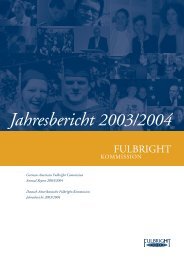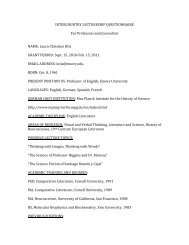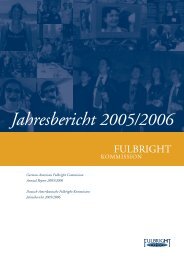Funnel 40/2, Inhalt - Fulbright-Kommission
Funnel 40/2, Inhalt - Fulbright-Kommission
Funnel 40/2, Inhalt - Fulbright-Kommission
Create successful ePaper yourself
Turn your PDF publications into a flip-book with our unique Google optimized e-Paper software.
30<br />
FROM OUR FULBRIGHTERS<br />
“Si, se puede – Yes, we can!”<br />
The message is simple for this protester on the<br />
immigrant workers’ freedom ride.<br />
THE FUNNEL • VOLUME <strong>40</strong> • NUMBER 2 • SUMMER 2004<br />
Non-documented immigrants in the U.S.<br />
F<br />
by Johannes Kloha<br />
The large lobby of the Illinois State Capitol in Springfield is filled<br />
with a crowd of perhaps 1000 people: men, women, and children. They<br />
move from one room to another and finally gather in front of the<br />
entrance to one of the chambers, where the legislature just came together<br />
to vote on a number of proposals. The architecture of the building is<br />
impressive. As with many other state capitols it seems at the same time<br />
to copy and compete with the Capitol in Washington D.C.<br />
But the large group of people is not here to admire the beauty of<br />
the construction, neither are they listening to the sophisticated explanations<br />
of some tourist guide. Their guide, a young woman, leads<br />
them with a loud and clear voice into a swelling chant of a few simple<br />
Spanish words: “Si, se puede, si, se puede…! ” – Yes, we can! And<br />
soon the noise shows results. A group of parliamentarians steps out<br />
of the room and after politely asking the crowd to lower their voices<br />
they get involved in a brief discussion with the group.<br />
I am with a large delegation of immigrants during the lobby day<br />
of the Illinois General Assembly where they are advocating for a legislative<br />
proposal they consider an important step ahead in their struggle<br />
for equal rights. Today, the legislature is voting on a bill that would<br />
give immigrants without legal documentation the possibility to<br />
acquire a driver’s license—a crucial document of identification in the<br />
U.S. And indeed, many of the participants are in the U.S. without<br />
legal residency and hope to directly benefit from their engagement.<br />
I ask Manuel, a young man, why he is joining this group. He answers,<br />
“Because I want a driver’s license!”<br />
I joined this group as part of my internship at Erie Neighborhood<br />
House, one of the oldest community organizations in Chicago. Since<br />
its founding in 1870 its main purpose has been to assist the residents<br />
of the neighborhood, West Town, through a variety of social services.<br />
West Town is one of Chicago’s neighborhoods with a very high percentage<br />
of immigrants from South, Middle, and Central America,<br />
predominantly from Mexico.<br />
Right now Erie House offers childcare for low-income parents, a<br />
youth program with various options for teenage kids ranging from<br />
recreational facilities to computer classes, field trips, and a tutoring<br />
system that prepares high school seniors for college. In adult education<br />
classes immigrants can learn English or prepare themselves for<br />
the citizenship exam, which requires basic knowledge of the history<br />
and political system of the United States. Additionally, immigrants



